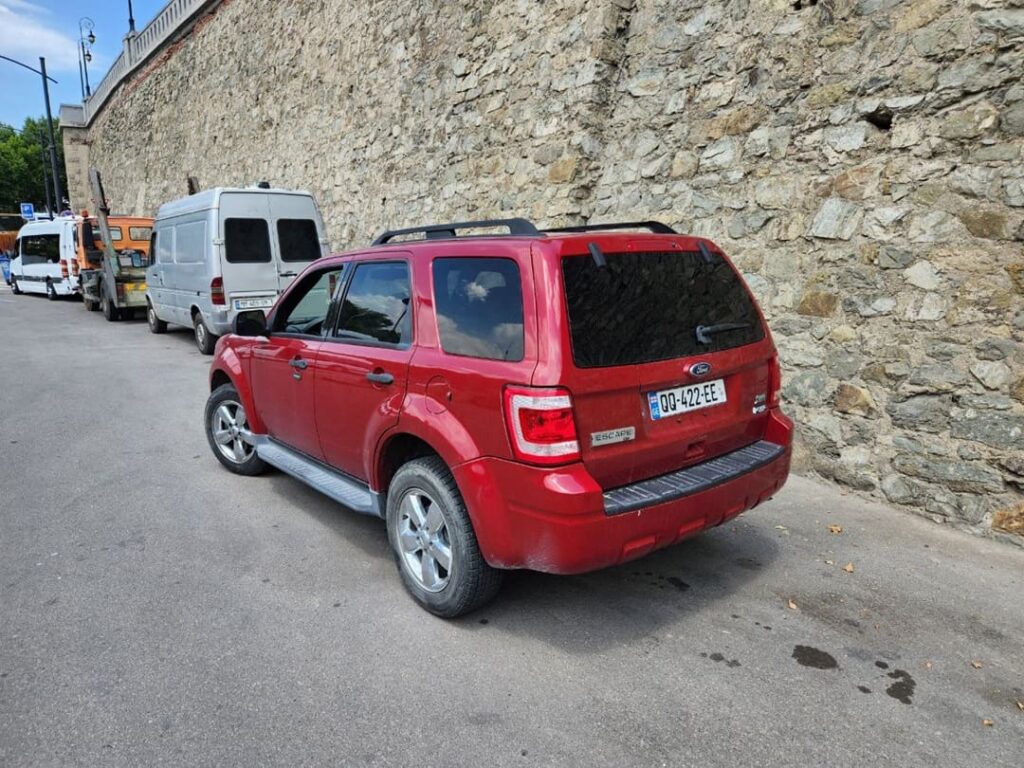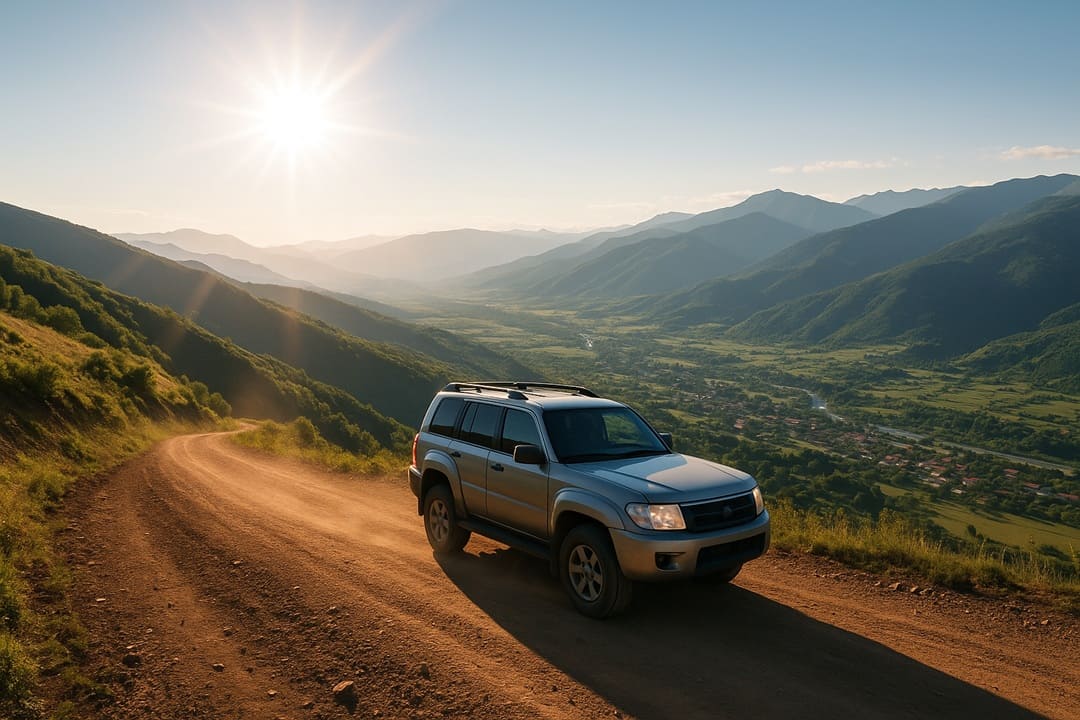There are road trips — and then there are Georgian road trips. You know the kind: winding paths through misty canyons, rivers splashing across half-built roads, cows blocking the way with zero intention of moving. Welcome to Georgia’s mountains — where adventure begins the moment your GPS gives up.
For travelers hungry for something raw, real, and completely unforgettable, off-roading in Georgia offers an experience few places can match. But make no mistake — this isn’t a drive down California’s Highway 1. It’s wild, unpredictable, and occasionally humbling. If you’re thinking of renting a 4×4 and pointing your tires toward Tusheti or Svaneti, here’s what you really need to know — from choosing the right vehicle to avoiding a heart-to-heart with a ravine.
Why Georgia is the Ultimate Playground for Off-Road Travel
It starts with the terrain. Georgia is small — smaller than South Carolina — but packed with drama: alpine peaks, medieval towers clinging to cliffs, canyons, desert-like badlands, and river valleys so deep your ears pop going in and out. While the main highways connect the big dots like Tbilisi, Batumi, and Kutaisi, the real treasures lie far off the asphalt.
Tusheti, a remote region in the northeast, is a kind of pilgrimage for off-roaders. Getting there means driving the Abano Pass, a road so high and narrow it only opens for a few months a year, and even then only when the snow has melted and the mud isn’t too ambitious. It’s often labeled “one of the world’s most dangerous roads” — which sounds dramatic until you’re hugging a cliff edge with no guardrail, no cell signal, and a Georgian sheepdog trotting happily ahead of you like it owns the mountain.
The payoff? You reach ancient villages like Omalo and Dartlo, where time slows down, hospitality flows like chacha, and the landscape feels like something from another planet. But Tusheti’s not alone — regions like Khevsureti, Svaneti, Racha, and Vashlovani each offer their own flavor of off-road exploration, from high mountain switchbacks to semi-desert safari-style trails.
Renting the Right 4×4 – What to Know Before You Book
Not all 4x4s are created equal — and in Georgia, that really matters. Sure, a fancy SUV with tinted windows and plush seats looks great on Instagram. But will it get you up a loose gravel slope at 2,800 meters with rain threatening to turn the track into pudding? Doubtful.
If your destination includes passes like Abano or trails in Omalo or Ushguli, skip the “soft-roaders” and look for rugged models like the Toyota Land Cruiser, Mitsubishi Pajero, or Nissan Patrol. Older models might be less photogenic, but they’re often better suited for these roads — simpler, more durable, and with higher clearance. Some local rental agencies even modify their cars specifically for these conditions, adding better tires, reinforced suspension, and roof racks for jerry cans or spare tires.
Another crucial factor is transmission. Many travelers unfamiliar with manual cars make the mistake of booking one without realizing it. But ironically, for steep climbs and tricky downhills, a manual gearbox actually gives you more control. If you’re confident with a stick shift, it’s a better choice. If not, make sure you confirm automatic availability well in advance — Georgia’s rental fleets are growing, but automatics are still in the minority.
And ask — seriously, ask — whether the car has low-range gearing. That’s the off-road equivalent of discovering superpowers when you hit rough stuff. You might not need it in Batumi, but once you leave paved roads behind, you’ll be glad you have it.
Realities of Driving Off-Road in Georgia — From Rockslides to River Crossings

If you’re picturing smooth gravel roads and a few Instagram-worthy bumps — reset that fantasy. This is real off-road. The kind where maps lie, weather shifts hourly, and rocks have a habit of rolling onto roads mid-conversation.
In regions like Tusheti or Khevsureti, roads are usually unpaved and barely wide enough for one vehicle. Oncoming traffic means negotiating cliffside standoffs or reversing blind around bends while trying not to breathe too hard. Landslides can block your path without warning. Water crossings can turn shallow trickles into impassable floods after a single mountain rainstorm.
Road maintenance in these areas is limited at best. That said, locals are resourceful, and you’ll often find someone with a shovel, a winch, or at least a cheerful shrug ready to help. But don’t count on roadside assistance. You are your own support team, so take it seriously
Packing Smart — Essentials That Can Save You (or Your Trip)
There’s a fine line between adventure and disaster — and it often comes down to what’s in your trunk. If you’re heading into remote areas, pack as if you’re not coming back the same day (even if you are). That means:
- Plenty of drinking water and snacks
- A spare tire (yes, really check that it’s there)
- Jumper cables or a portable battery pack
- Basic tools, like a wrench and tire iron
- A printed map — internet dies often in the mountains
- Cash — because no one in Dartlo takes cards
- Layers of clothing — weather changes fast
You’ll also want Google Maps, Maps.me (for offline access), and maybe even Gaia GPS if you’re getting serious. And remember: most Georgian mountain roads don’t appear correctly on international mapping apps. When in doubt — ask a villager. Or a cow. They seem to know the way.
Safety, Sanity, and Mountain Etiquette
Let’s talk fear. Not in a scary way — just real talk. These roads can be intimidating, especially if you’re not used to off-road driving. The best advice? Take it slow. Locals may fly down mountain paths like they’re in a rally, but you don’t have to.
Use engine braking on descents. Don’t ride the brakes — that’s a fast way to lose them entirely. If you encounter a vehicle coming the other way, the car heading uphill usually has the right of way. And don’t be afraid to stop and assess before crossing a stream or negotiating a hairpin. You’re not holding up traffic — you are the traffic.
One more tip: don’t drive after sunset. There’s zero lighting, animal crossings, and fog that moves like something out of a horror movie. It’s beautiful by day and dangerous by night. Plan your routes to always be back — or in a guesthouse — by dusk.
Where to Go – Legendary Off-Road Routes
Georgia offers no shortage of routes that can test your nerves and reward your soul. A few top picks:
Abano Pass to Tusheti: Open only 3–4 months a year (typically mid-June to early October), this 70 km stretch connects Kakheti with Omalo. It climbs to over 2,800 meters and is infamous for its hairpins, steep drops, and unpredictable conditions. You’ll feel every meter — and never forget it.
Zagaro Pass (Ushguli to Lentekhi): A remote mountain route connecting Upper Svaneti to Racha. It’s one of Georgia’s most scenic but also roughest drives, especially after rain. Expect waterfalls pouring across the road, cows doing traffic control, and maybe one or two trucks hauling logs like it’s a game.
Vashlovani National Park: Georgia’s version of a semi-desert safari. You’ll need a 4×4 not for elevation but for dryness — dusty, cracked roads with wild horses, fossil canyons, and surreal sunsets. You might even spot a lynx if you’re lucky (or unlucky, depending on your perspective).
Is It Worth It? Absolutely — If You Know What You’re Getting Into
Renting a 4×4 and venturing into Georgia’s highlands isn’t for everyone. It’s not always comfortable, definitely not predictable, and at times a little terrifying. But it’s also the kind of travel that sticks with you — not because it’s easy, but because it’s real.
You’ll have stories. Like the time your car got blocked by a herd of sheep, and the shepherd invited you in for wine. Or when you thought you were lost, only to find a 9th-century watchtower on a hill that wasn’t on any map. Or when the road literally disappeared and a local kid drew you a new one in the dirt.
These are the moments that turn a trip into a memory.
Ready for the ride? Good. Just don’t forget the snacks, a real spare tire, and maybe a quick prayer to the mountain gods.

